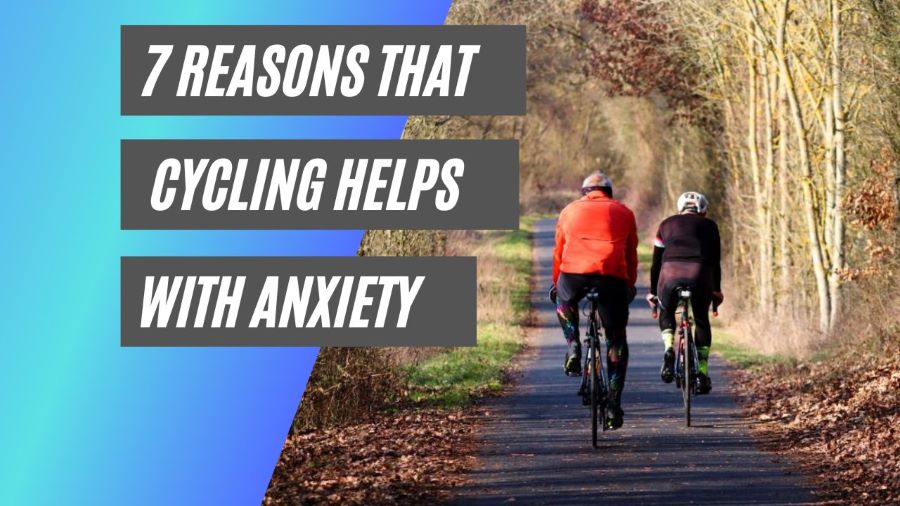This post may contain affiliate links. If you click an affiliate link and make a purchase, I may earn a commission. Also, as an Amazon Associate, I earn from qualifying purchases.--
Many anxiety sufferers report that riding a bike is an activity that captures both the mind and body. There are so many muscles and movements you have to coordinate.
You also have to use your brain to decide the best path, when, and where to turn. It is a mindful experience.
There’s also the added benefit of cycling around landscapes, where you can simultaneously enjoy the views.
Releasing endorphins and dopamine together? In one simple activity? That’s right!
Here are 7 reasons that cycling helps with anxiety:

7 Reasons That Cycling Helps With Anxiety
If you’ve ever gone on a cycling session, you would understand the term “cycling high.” This is not a myth, science says. (Source)
So, what’s the story behind that? Let’s look into it.
1. Releasing Endorphins
When you’re cycling, your body releases endorphins. Typically, your body releases these chemicals as a response to pain. In other words, endorphines are natural painkillers.
During exercise, such as cycling, nothing is causing you physical pain. So, when the painkiller effect of endorphins comes into play, it relieves anxiety and helps you feel energized.
2. Releasing Dopamine
Studies show that cycling is an excellent way to boost dopamine. Dopamine is the feel-good neurotransmitter that the body releases when we’re happy. (Source)
So, you can start your ride feeling bummed out from work or personal life, but you’ll end up energized.
Consequently, this uplifts your general mood, making you feel more sociable and agreeable with the people you come across.
3. Releasing Serotonin
Another neurotransmitter that cycling boosts is serotonin. This chemical is the messenger to your body. It carries signals between nerve cells, and it’s responsible for plenty of functions.
Some of the most important of those are mood, sleep, and cognitive modulation.
Think of this, your body is releasing painkillers and happy chemicals, and then the messenger is getting stronger!
After cycling, you’ll be feeling at the peak of your relaxation and contentment as these feelings are effectively flowing through your entire body thanks to the excess of serotonin.
4. Exposure to Sunlight
One of the biggest benefits of cycling is getting exposure to sunlight. Sunlight gives us Vitamin D, which is essential to our nervous system’s health.
This is why experts recommend commuting to work on a bike. It gives you exposure to natural light while getting some exercise in.
Not only that, but it’s also the most environmentally-friendly way to get to work.
Besides, biking to work relieves stress, leaving you refreshed and ready to handle whatever your day at work throws your way.

5. Growing Your Brain
Cycling enhances blood flow, which encourages cellular growth. We’re not talking just your glutes and quads, we also mean circulation to your brain.
This surge of blood means that your brain makes way for new blood vessels where more oxygen can flow. In turn, this means more nutrients.
The result is that you get better overall brain activity. Consequently, you’ll be feeling like your memory is better. You’ll also notice that you’re getting better with cognitive tasks.
Not only that, but it keeps your brain young and healthy by generating new neurons. It’s not just neurons, but dopamine receptors, too.
With regular exercise, you’ll be getting a good dose of dopamine. After a while, your brain will make way for more of it by creating more receptors.
So, the happiness you feel from riding a bike will only bring you more!
Here is a quick table that summarizes all the positive hormones that cycling generates, and their impact:
| Hormone | Impact |
| Dopamine | Dopamine is a brain hormone that helps you feel pleasure, satisfaction, and motivation |
| Oxytocin | The hormone can create anti-stress effects. It reduces cortisol levels and blood pressure. It is stimulated by social interactions. |
| Serotonin | This hormone is created in the brain and spinal cord. It helps to regulate attention, the digestion, and body temperature. |
| Endorphins | This hormone is released by the body during stress, pain, exercise, sex, and eating. They help reduce stress, and relieve pain. |
6. A Form of Meditation
Everyone knows meditation is a way to get to an overall more relaxed state. However, it’s not always so easy to bring your focus and concentration to one thing.
Luckily, riding a bike can help you do just that with minimal effort.
No matter how long you’ve been cycling, your brain will always be engaged when you’re on the bike.
On the one hand, you’re actively keeping your balance. On the other hand, you’re always thinking of when to cycle faster, slower, stop, take over, and so on.
Although it can be somewhat mindless after a while, it’ll always take a degree of mental concentration to keep yourself up and running on the bike.
I found the following video on Youtube that likens meditation to riding a bike. This is on the mindfulness Headspace channel:
7. An Opportunity to Bond
Cycling is a great way to socialize and bond. You can join a cycling community, where people get together for rides and trips.
Alternatively, you can go cycling with a friend that’s already big on the sport.
In all cases, the mix of feel-good chemicals —serotonin, dopamine, and endorphins— can only get better with the trust chemical that you release with people you love: oxytocin.
This puts you in a cycle of dopamine release, being friendly and agreeable, making friends, and bonding well with them.
There’s no wonder that cycling is popular for feeling good and improving life satisfaction overall.
FAQs
How Long Do I Have to Cycle to Relieve Anxiety?
Studies show that you begin to release endorphins about 30 minutes from the beginning of physical exercise. So, make sure you put in a minimum of half an hour for your ride.
How Often Do I Have to Cycle to Get the Benefits?
Instead of doing one long ride per week, you should aim for at least three ones, even if they’re short.
Consistent cycling has better results on both your physical and mental health than inconsistent rides, even if they’re longer.
Does Cycling Relieve Depression?
Just as evidence shows that cycling positively affects anxiety, it has the same positive effects on depression.
Studies show that cycling to work increases people’s well-being, reduces psychological distress levels, and increases overall life satisfaction.
Final Thoughts
As with any physical exercise, cycling is a surefire way to relieve anxiety. It positively affects brain chemistry, almost in the same way drugs do!
If you put in around 30 minutes of cycling three to five days every week, you’ll certainly see improvement in your overall mental health.
It’s one of the safest, most natural, cleanest, and most enjoyable ways to a better life.
So, what are you waiting for? Get down to riding and put your pedal to the metal!
